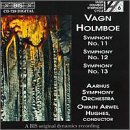| All Artists: Vagn Holmboe, Owain Arwel Hughes, Aarhus Symphony Orchestra Title: Vagn Holmboe: Symphonies Nos. 11-13 Members Wishing: 1 Total Copies: 0 Label: Bis Release Date: 5/21/1996 Album Type: Import Genre: Classical Style: Symphonies Number of Discs: 1 SwapaCD Credits: 1 UPC: 789368363629 |
Search - Vagn Holmboe, Owain Arwel Hughes, Aarhus Symphony Orchestra :: Vagn Holmboe: Symphonies Nos. 11-13
 | Vagn Holmboe, Owain Arwel Hughes, Aarhus Symphony Orchestra Vagn Holmboe: Symphonies Nos. 11-13 Genre: Classical
|
Larger Image |
CD DetailsSimilar CDs
|
CD ReviewsHolmboe's Cosmic Finale Thomas F. Bertonneau | Oswego, NY United States | 10/27/2000 (5 out of 5 stars) "Denmark might be the 21st century welfare state par excellence, but the nation's classic literature gives a darker, even a haunted, impression of the Danish soul. In Jens-Peter Jacobsen's two 19th century masterpieces, "Niels Lyhne" and "Maria Grubbe," the countryside broods, the towns are muddy, the long winter brutalizes poor souls. In his "Songs of Gurre," Jacobsen recalls the feuds and passions of the medieval period. In "Lucky Kristoffer," meanwhile, the 20th century master Martin A. Hansen shows us a Denmark afflicted by the miseries of the Thirty Years War. Karen Blixen summed up the trend when she titled her most-read cycle of novellas, published at the time of World War II, "Seven Gothic Tales." Much more than his illustrious precursor Carl Nielsen, Jutland-born Vagn Holmboe (1909-1996) strikes me as musically part of this "Gothic Denmark." Like the trio of writers mentioned above, Holmboe, one of whose hobbies was the planting and tending of trees, cultivated a keen sense of the earth in its seasons. He knew the natural processes, the hidden changes beneath the soil, the running of the sap in autumn, and the quickening in the air at the end of winter. His music reflects this earthward orientation; it deals in long-drawn, seamless, transformations, and in the clash and succession of elemental forces. The final trio of symphonies (11 [1980], 12 [1988], and 13 [1994]) represents the perfected synthesis of all the characteristic Holmboe traits: Continuous transformation of simple motifs; dense but luminous polyphony; a constant but deeply sublimated presence of Danish folksong; a tendency to qualified optimism in the closing bars. Consider, for example, the ultimate symphony, No. 13. It is in three movements, all marked "Allegro." The First Movement begins with a ryhthmically marked "conflict motif" in the horns, followed by an undulating movement in strings, both of which seem to come together in a martial passage with much punctuation from the battery; the undulation returns in flutes and is taken up by other winds, then challenged by horns and trumpets. Along the way we hear delicate comments from the celesta. The variety and rapid succession of the moods dazzle the mind, but never suggest the episodic. The Second Movement relaxes a bit, with an episode, largely for strings, marked "Calmo," before becoming animated, even strident, again in its coda. The Third Movement returns to the conflicted landscape of the First, but gradually transforms the familiar horn-figure into something hymnic and reconciling. The ethereal sounds ("Calmo" once again) remind us of another Holmboe trait that acquires geat importance in the last three symphonies: A Cosmic feeling, partly religious, partly esthetic, at once lyrical and impersonal. One finds just the same feeling in Jacobsen's evocations of nature, or at the beginning of Blixen's novella, "The Dreamers." There is no need to comment on Symphonies Nos. 11 and 12. They are "of a piece" with No. 13. With the coupling of Nos. 8 and 9, this is one of the high points of the Hughes/Holmboe cycle on BIS." The Final Works of Vagn Holmboe Grady Harp | Los Angeles, CA United States | 05/15/2006 (5 out of 5 stars) "For those yet to experience the symphonic works of Danish composer Vagn Holmboe this excellent recording by Owain Arwel Hughes conducting the Aarhus Symphony Orchestra is a fine way to appreciate a much-underrated composer. These final three symphonies - Symphony No. 11, Op. 144, 1980, Symphony No. 12, Op. 175, 1988, and Symphony No. 13, Op. 192, 1994 (the composer died in 1996) - reflect all that is the finest in his large output of works for chamber ensemble, choral groups, and large orchestral works.
Though Holmboe's orchestration grew in complexity during his lifetime, the aspects of his works uniquely his remained constant: his isolation of a single simple motif metamorphosing into richly molded polyphony, his inherent infatuation with folk melodies from the vast tundra of Denmark as well as from his time spent exploring the folklore of Eastern European countries, and his exalted concluding statements - all are used to perfection in these final works. Though not much has been written about Holmboe, from his music we can deduct that he was a man fascinated with the unexplored, whether those be the stretches of the Nordic lands toward the north or the vastness of the universe beyond the globe. His ability to reach for great explosions of energy while also taming that energy in his gently beautiful, if tenuous, softer passages shows his kinship with Carl Nielsen, yes, but also with the great artist Vilhelm Hammershoi: out of the darkness that pervades Denmark are the light sources all the more beautiful for their scarcity. Holmboe will have his day. All that is needed is an emphasis on his mighty body of work in our concert halls to seduce the public ear with the mysteries of his talent. Highly Recommended. Grady Harp, May 06 " |

 Track Listings (9) - Disc #1
Track Listings (9) - Disc #1